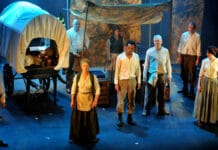The Windhover is a profound sonnet celebrating the beauty of a falcon in flight, drawing parallels between the bird’s majesty and Christ’s sacrifice and spiritual resilience. It is a sonnet written in 1887 by the Jesuit priest Gerard Manley Hopkins, dedicated to “Christ our Lord.” In the poem, the speaker recounts the awe-inspiring sight of a falcon (a “windhover”) soaring through the air in search of prey. The speaker is deeply moved by the bird’s aerial skill —its ability to both hover in stillness and swoop down with speed —and sees the bird as an expression of the beauty and majesty of God’s creation.
The Windhover is a celebration —perhaps a kind of joyous prayer —that marvels at the wonders of the natural world and, in turn, the majesty of God’s creation. The poem strives to show that these two aspects of the world —nature and God —are not separate: the beauty of nature is both evidence of and a way of experiencing God’s sublime divinity. The poem uses one small part of nature —a falcon —to explore this relationship, with “the achieve of, the mastery” of the bird representing one small but undeniable proof of God’s power.
Summary
The windhover is a bird with the rare ability to hover in the air, essentially flying in place while it scans the ground in search of prey. The poet describes how he saw (or “caught”) one of these birds amid its hovering. The bird strikes the poet as the darling (“minion”) of the morning, the crown prince (“dauphin”) of the kingdom of daylight, drawn by the “dappled” colours of dawn. It rides the air as if it were on horseback, moving with steady control like a rider whose hold on the rein is sure and firm. In the poet’s imagination, the windhover sits high and proud, tightly reined in, wings quivering and tense. Its motion is controlled and suspended in an ecstatic moment of concentrated energy. Then, in the next moment, the bird is off again like an ice skater balancing forces as he makes a turn. The bird, first matching the wind’s force to stay still, now “rebuffs the big wind” with its forward propulsion. At the exact moment, the poet feels his heart stir, or lurch forward out of “hiding,” as it were—moved by “the achieve of, the mastery of” the bird’s performance.
The sestet’s opening further elaborates on the bird’s movement and an injunction to the poet’s heart. The “beauty,” “valour,“ and “act“ (like “air,” “pride,“ and “plume”) “here buckle.” “Buckle“ is the verb here; it denotes either a fastening (like the buckling of a belt), a coming together of these different parts of a creature’s being, or a passive collapse (like the “buckling“ of the knees), in which all parts subordinate themselves into some larger purpose or cause. In either case, a unification takes place. At the moment of this integration, a glorious fire issues forth of the same order as the glory of Christ’s life and crucifixion, though not as grand. According to the speaker, fire is the source of all existence and is stunningly beautiful.
Analysis
The Windhover follows the pattern of many of Hopkins’s sonnets in that a sensual experience or description leads to a set of moral reflections. Part of the poem’s beauty lies in how Hopkins integrates his masterful description of a bird’s physical feat with an account of his heart’s response at the end of the first stanza. However, the sestet has puzzled many readers because it seems to diverge so widely from the material introduced in the octave. In line nine, the poem shifts into the present tense, away from the recollection of the bird. The horse-and-rider metaphor with which Hopkins depicted the windhover’s motion now gives way to the phrase “my chevalier”—a traditional Medieval image of Christ as a knight on horseback, to which the poem’s subtitle or dedication gives the reader a clue. The transition between octave and sestet comes with the statement in lines 9-11 that the natural (“brute”) beauty of the bird in flight is but a spark in comparison with the glory of Christ, whose grandeur and spiritual power are “a billion times told lovelier, more dangerous.”
The first sentence of the sestet can be read as either descriptive, imperative, or both. The idea is that something glorious happens when a being’s physical body, will, and action are all brought according to God’s will, culminating in the perfect self-expression. Hopkins, realising that his own heart was “in hiding“ or not fully committed to its purpose, draws inspiration from the bird’s perfectly self-contained, self-reflecting action. Just as hovering is the windhover’s most distinctive and self-defining action, spiritual striving is man’s most essential aspect. At moments when humans arrive at the fullness of their moral nature, they achieve something great. But that greatness necessarily pales in comparison with the ultimate act of self-sacrifice performed by Christ, which nevertheless serves as our model and standard for our behaviour.
The final tercet within the sestet declares that this phenomenon is not a “wonder,“ but rather an everyday occurrence —part of what it means to be human. This striving, far from exhausting the individual, brings out his or her inner glow —much as the daily use of a metal plough, instead of wearing it down, actually polishes it —causing it to sparkle and shine. The suggestion is that there is a glittering, luminous core to every individual, which a concerted religious life can expose. The subsequent image is of embers breaking open to reveal a smouldering interior. Hopkins uses this image to relate the concept to the Crucifixion: The verb “gash“ (which doubles for “gush”) suggests the wounding of Christ’s body and the shedding of his “gold-vermilion“ blood.
Form
The poem follows the Italian sonnet form, with an octave (first eight lines) presenting the description of the bird and a sestet (final six lines) transitioning into spiritual reflections —the seamless shift from the physical to the spiritual highlights Hopkins’ mastery of the sonnet form. The confusing grammatical structures and sentence order in this sonnet contribute to its difficulty but also represent a masterful use of language. Hopkins blends and confuses adjectives, verbs, and subjects to echo his theme of smooth merging: the bird’s perfect immersion in the air, and the fact that his self and his action are inseparable. Note, too, how vital the “-ing“ ending is to the poem’s rhyme scheme; it occurs in verbs, adjectives, and nouns, linking the different parts of the sentences together in an intense unity. Many verbs are packed into a short space of lines, as Hopkins tries to pinpoint the exact character of the bird’s motion with as much descriptive precision as possible.
The Windhover is written in “sprung rhythm,“ a meter in which the number of accents in a line is counted, but the number of syllables does not matter. This technique allows Hopkins to vary the speed of his lines to capture the bird’s pausing and racing. Listen to the hovering rhythm of “the rolling level underneath him steady air,“ and the arched brightness of “and striding high there.“ The poem slows abruptly at the end, pausing in awe to reflect on Christ.
Theme
At its core, The Windhover is an ode to spiritual resilience and Christ’s redemptive sacrifice. Through the kestrel’s flight, Hopkins explores themes of mastery, divine beauty, and the paradox of strength emerging from surrender or fall.
Language and Imagery
Nature Imagery
The bird is celebrated as a natural marvel, with descriptions like “dapple-dawn-drawn“ emphasising its harmonious existence within creation.
Religious Symbolism
The kestrel’s fall represents Christ’s crucifixion, while its subsequent rise mirrors His resurrection.
Kinetic Imagery
Words such as “sweep,” “gliding,“ and “buckle“ convey the bird’s dynamic movement, embodying both grace and force.
Use of Contrast
The poem juxtaposes brute force and delicate control, as seen in the kestrel’s flight, and parallels this with the paradox of Christ’s strength through suffering. The bird’s natural prowess is likened to spiritual majesty, showing how earthly beauty can reflect divine truths.
Emotional Resonance
Hopkins infuses personal devotion into the poem, evident in his deep admiration for the bird and his reverence for Christ. The transition from awe of nature to a reflection on spirituality evokes both wonder and reverence.
The Windhover is a masterful blend of natural observation and spiritual meditation. Hopkins celebrates the kestrel as a physical marvel and a metaphor for Christ’s redemptive power. The poem’s intricate language, rhythmic energy, and profound imagery make it a cornerstone of Hopkins’ poetic legacy and a timeless exploration of the interconnectedness of nature, divinity, and human experience.



























